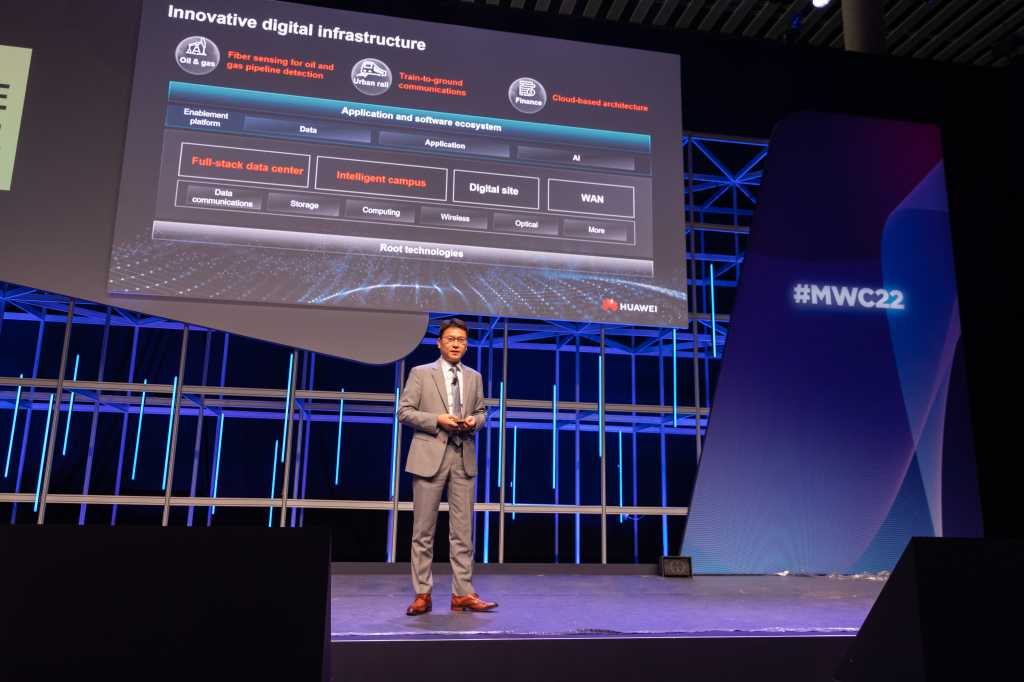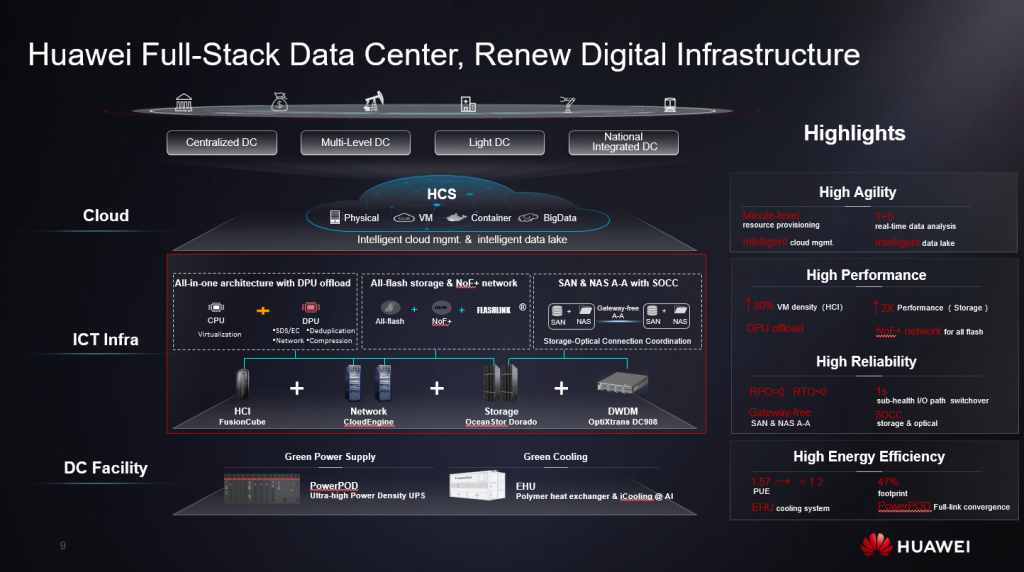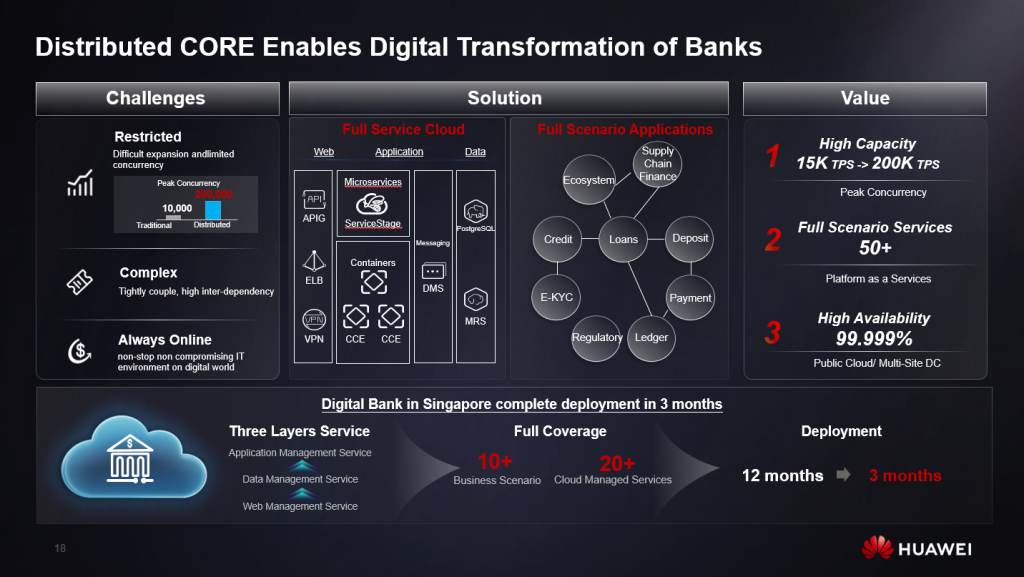As the ongoing digital transformation unlocks the potential of industries, the global digital infrastructure is also facing a higher demand. According to Huawei’s Global Industry Vision (GIV), by 2030, there will be 23 times more global data, 10 times more global general computing power, and 500 times the global AI computing power. We will also see 200 billion connections worldwide. The innovation of digital infrastructure is more urgent than ever.
Meanwhile, the second decade of the 21st century is also marked by the pursuit of global energy transition and sustainable development, which means the innovation of digital infrastructure should also be a greener and more efficient one.
Typically, the innovation of digital infrastructure happens in the following three levels.
First, continuous innovation on the product level, such as wireless network, computing, data storage, and optical transmission. There is still massive demand on this level, especially when you consider the amount of legacy IT hardware still in use today.
Second, scenario-based solutions for intelligent campuses, digital sites, and wide area networks (WANs).
Third, industrial solutions jointly developed by tech companies and their partners, which are widely applied in the financial services, energy, transportation, and public sectors.
At the recent Mobile World Congress (MWC) 2022, Huawei teamed up with industry partners to showcase its innovations in all three levels, and also how those innovations create new value together with customers from various industries, spanning government and public sector to finance, transportation, energy, manufacturing, and Internet Service Providers (ISPs).
Solid foundation
Each product-level innovation means a more solid foundation of digital infrastructure in an intelligent world. According to Gartner, by 2025, 75% of organizations will use cloud services. The proportion of large data centers with more than 3,000 racks will increase to 36%. Carbon neutrality goals set by more and more countries are demanding more energy-saving features for data centers. In a nutshell, an innovative digital infrastructure calls for data centers that are more cloud-based, more intensive, and greener.

Huawei
During the Industrial Digital Transformation Summit of MWC 2022, Chen Banghua, Vice President (VP) of the Huawei Enterprise Business Group (BG), introduced the full-stack data center, which represents Huawei’s latest progress in product-level innovation.
- At the facility layer, Huawei PowerPod reduces the carbon footprint by 47%; EHU (environment handling unit) of the polymer heat exchanger maximizes the use of free cooling sources and reduces the PUE to 1.2, saving energy by over 14% each year compared with conventional cooling systems.
- At the ICT infrastructure layer, the all-flash storage latency is reduced to 0.05ms, two times faster than the industry level; the number of VMs (virtual machines) on a single server increases by 30%.
- At the cloud platform layer, Huawei’s intelligent cloud management and data lake make service and management more agile.

Huawei
The power of integration
In enterprise IT, scenario-based solutions consist of multiple products are usually an important step in the journey of digitalization. By leveraging its expertise from telecom technology, Huawei has developed an intelligent campus solution for organizations redesigning their future of work, life, and study.
When all-wireless access, next-generation network, and hyper-converged IT infrastructure are combined in one, the Huawei intelligent campus solution brings improvement in operating efficiency and user experience with lower costs.
As one of the biggest beneficiaries of this intelligent campus, higher education, especially in developing countries, is achieving its digital transformation strategy, says Juan Carlos Soto Baquero, the Executive Director of the Technology and Multimedia Convergence Project for CSUCA (Central American University Confederation) during the summit.
This is partly because of the next-generation integration. Currently, most equipment rooms house a variety of devices: power conversion, UPS, power supply control module, air conditioner, etc. At an intelligent campus, a FusionModule will do the job for all, integrating computing, data storage, network, and security functions in one box.
Besides, an all-wireless environment is the most prominent feature of an intelligent campus. Behind this future-proof campus solution is Huawei AirEngine Wi-Fi 6, whose Dynamic Turbo and Lossless Roaming technology ensure smooth connection for real-time services such as video conferencing and precise control of Automatic Guided Vehicles (AGVs).
From package to practice
For many tech companies, working with customers in multiple industries helps them overcome the last gap between the product or solution innovation and a real impact on the economy. During the MWC 2022, Huawei demonstrated three industrial solutions jointly developed with its partners from the energy sector, transportation, and financial services.
In the energy sector, Huawei is working with DEWA as a technical partner to support its initiative of building the world’s first digital utility utilizing autonomous systems for renewable-energy, says Rashid Alahmedi, COO of InfraX Digital DEWA (Dubai Electricity & Water Authority).
In transportation, Huawei’s train-to-ground communication solution provides real-time service transmission with a bandwidth of up to 1.4 Gbps for trains running at speeds of up to 160 km/h. The network switching latency is less than 30ms, assuring the stable operation of urban rails.
The financial service sector, as pointed out by Dr. Barbara Kolm who spoke as the Vice President of the Austrian Central Bank during the summit, also as new requirements for infrastructure digitalization, including innovation into the core banking systems, and higher degree of interoperability and security. Based on the next-generation IT architecture, Huawei partners build various applications, from traditional services such as deposits and loans, as well as innovative applications such as digital loans and e-payment. A digital bank in Singapore shortened the deployment of service from 12 months to three months.

Huawei
Value and vision
To make the most of the fruit of digital transformation, non-stop innovation in digital infrastructure will be essential. Furthermore, this innovation should be driven by value and vision.
On the one hand, tech companies should work with industry customers to develop more competitive and sustainable solutions and create new value together; on the other hand, the vision of ”Building a Fully Connected, Intelligent World” is consistently behind every technological breakthrough, fueling ongoing innovation.
Huawei works with more than 30,000 partners to serve global customers, including 267 of the Fortune Global 500 companies who choose Huawei for their digital transformation.
MWC 2022 in Barcelona
Huawei teamed up with industry partners at MWC 2022 to showcase innovative solutions and practices, spanning government and public sectors to finance, transportation, energy, manufacturing, and ISPs. Huawei focused on industrial digital transformation, digital infrastructure innovation, and carbon emissions reduction. In addition, Huawei also released a series of scenario-based industry solutions, full-stack data center and intelligent campus solutions, as well as the company’s latest datacom, optical, and storage products. Learn more here.
Read More from This Article: Why Companies Need Three-Level Innovation in Their Digital Infrastructure
Source: News

